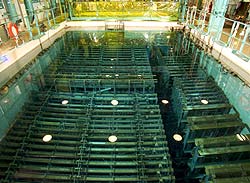
Spent Fuel Management
The Savannah
River Site provides for the safe receipt and interim storage
of irradiated spent nuclear fuel (SNF) assemblies from domestic
and foreign test and research reactors. The fuel is stored
in underwater facilities until it is stabilized for final
disposition.
SRS’s
spent nuclear fuel is managed under various National Environmental
Policy Act documents, including the SNF Programmatic Environmental
Impact Statement, the Foreign Research Reactor Environmental
Impact Statement, the Interim Management of Nuclear Materials
Environmental Impact Statement, and the SRS SNF Environmental
Impact Statement.
L Area
Underwater storage facilities, called disassembly basins,
are located in all five of SRS’s reactor areas. These
facilities were designed to store spent nuclear fuel and target
assemblies discharged from the reactor cores. This storage
allowed the nuclear material to cool after being irradiated
in the reactors. The basins were also used to prepare the
nuclear materials for transport to the F and H Areas processing
facilities.
Only L Basin still
contains and receives fuel material. The basins have concrete
walls 3 feet thick and hold 3.5 million gallons of water with
pool depths of 17 to 30 feet. Although all assemblies are
now “cold” enough to no longer require water cooling,
water provides shielding to protect workers from radiation.
Each basin has
four main sections used to receive, prepare, and store the
fuel. The fuel assemblies are transferred through these sections
via narrow vertical gateways used to isolate the sections.
 In
1996, the L Basin equipment was reconfigured to safely handle
and store spent nuclear fuel (SNF) from off-site (foreign
and domestic) research reactors. The first off-site fuel was
received and stored in February 1997. In
1996, the L Basin equipment was reconfigured to safely handle
and store spent nuclear fuel (SNF) from off-site (foreign
and domestic) research reactors. The first off-site fuel was
received and stored in February 1997.
Inventories
include SRS fuel assemblies in addition to the thousands of
research reactor spent fuel assemblies received from offsite
facilities. Additionally, the basins contain other miscellaneous
nuclear materials, some of which will require special handling
and disposal. Thousands more assemblies are projected to be
received and stored in L Basin in the next decade.
|

